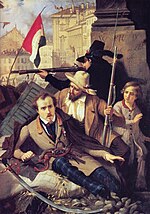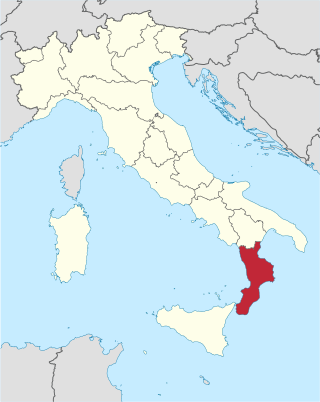
Calabria is a region in Southern Italy. It is a peninsula bordered by Basilicata to the north, the Ionian Sea to the east, the Strait of Messina to the southwest, which separates it from Sicily, and the Tyrrhenian Sea to the west. It has almost 2 million residents across a total area of 15,222 km2 (5,877 sq mi). Catanzaro is the region's capital.

Reggio di Calabria, commonly and officially referred to as Reggio Calabria, or simply Reggio by its inhabitants, is the largest city in Calabria as well as the seat of the Regional Council of Calabria. It has an estimated population between 150,000 and 200,000 and is the twenty-first most populous city in Italy, after Modena and other Italian cities, and the 100th most populated city in Europe. Reggio Calabria is located near the center of the Mediterranean and is known for its climate, ethnic and cultural diversity. It is the third economic centre of mainland Southern Italy. About 560,000 people live in the metropolitan area, recognised in 2015 by Italy as a metropolitan city. It holds the record of the worst city in terms of quality of life for environmental and cultural parameters, ranking among the worst Italian cities for quality of life.

Messina is a harbour city and the capital of the Italian Metropolitan City of Messina. It is the third largest city on the island of Sicily, and the 13th largest city in Italy, with a population of more than 218,000 inhabitants in the city proper and about 650,000 in the Metropolitan City. It is located near the northeast corner of Sicily, at the Strait of Messina and it is an important access terminal to Calabria region, Villa San Giovanni, Reggio Calabria on the mainland. According to Eurostat the FUA of the metropolitan area of Messina has, in 2014, 277,584 inhabitants.
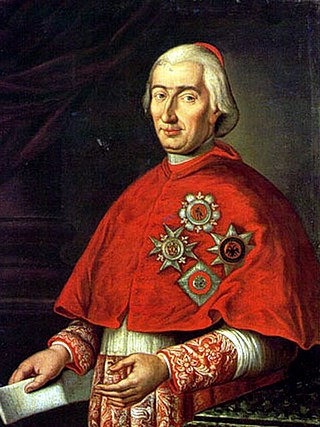
Fabrizio Dionigi Ruffo was an Italian cardinal and politician, who led the popular anti-Jacobin Sanfedismo movement.

Carlo Filangieri, prince of Satriano, was a Neapolitan soldier and statesman. He was the son of Gaetano Filangieri, a celebrated philosopher and jurist, and father of Gaetano Filangieri, prince of Satriano, an art historian and collector.
Martone is a comune in the province of Reggio Calabria, Calabria, Italy. Originating in the 7th and 8th centuries, the comune was founded by Greek Christian monks from the Byzantine Orient. The monks travelled from regions of the Aegean-Levantine to escape Syrian persecution.

The Sicilian revolution of independence of 1848 which commenced on 12 January 1848 was the first of the numerous Revolutions of 1848 which swept across Europe. It was a popular rebellion against the rule of Ferdinand II of the House of Bourbon, King of the Two Sicilies. Three revolutions against the Bourbon ruled Kingdom of the Two Sicilies had previously occurred on the island of Sicily starting from 1800: this final one resulted in an independent state which survived for 16 months. The Sicilian Constitution of 1848 which survived the 16 months was advanced for its time in liberal democratic terms, as was the proposal of a unified Italian confederation of states. It was in effect a curtain-raiser to the end of the Bourbon kingdom of the Two Sicilies, finally completed by Giuseppe Garibaldi's Expedition of the Thousand in 1860, the Siege of Gaeta of 1860–1861 and the proclamation of the unified Kingdom of Italy.

Gerace is a town and comune in the Metropolitan City of Reggio Calabria, Calabria, southern Italy. Gerace is located some 10 kilometres (6 mi) inland from Locri, yet the latter town and the sea can be seen from Gerace's perch atop a 500-metre (1,600 ft) vertical rock. The town stands on a hill formed of conglomerates of sea fossils from 60 million years ago. It is one of I Borghi più belli d'Italia.

Florestano Pepe was an Italian patriot. He was brother to the more famous general Guglielmo Pepe and cousin to Gabriele Pepe.
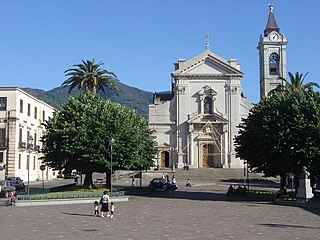
The Diocese of Oppido Mamertina-Palmi is a Latin diocese of the Catholic Church in southern Italy, existing under that name since 1979. Historically it was the Diocese of Oppido Marmertina (Oppidensis). It is a suffragan see of the Archdiocese of Reggio Calabria.
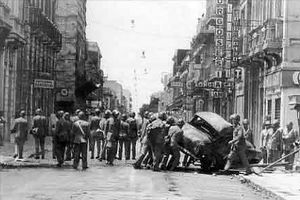
The Reggio revolt occurred in Reggio Calabria, Italy, from July 1970 to February 1971. The cause of the protests was a government decision to make Catanzaro, not Reggio, regional capital of Calabria. The nomination of a regional capital was the result of a decentralization programme of the Italian government, under which 15 governmental regions were concretized and given their own administrative councils and a measure of local autonomy.
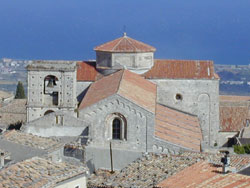
The Diocese of Locri-Gerace is a Latin diocese of the Catholic Church in Calabria. It is a suffragan of the Archdiocese of Reggio Calabria-Bova.

Giuseppe Morabito, nicknamed 'u tiradrittu, is an Italian criminal and a historical boss of the 'Ndrangheta, a Mafia-type organisation in the region of Calabria, in southern Italy. He hails from Africo in the Locride. He was a fugitive and on the list of most wanted fugitives in Italy from 1992 until his arrest in February 2004.

Sanfedismo was a popular anti-Jacobin movement, organized by Fabrizio Cardinal Ruffo, which mobilized peasants of the Kingdom of Naples against the pro-French Parthenopaean Republic in 1799, its aims culminating in the restoration of the Monarchy under Ferdinand I of the Two Sicilies. Its full name was the Army of Holy Faith in our Lord Jesus Christ, and its members were called Sanfedisti.
The Camera di Controllo, is a collegial body of the 'Ndrangheta, a Mafia-type organisation in Calabria in Southern Italy. It is also known as La Provincia or Camera di Compensazione. It is composed of leading 'Ndrangheta members to decide on important questions concerning the organization and settling disputes.
The following is a timeline of the history of the city of Reggio Calabria, Italy.

Rocco Verduci was an Italian revolutionary, and martyr of the Insurrection of 1847 in the Two Sicilies.
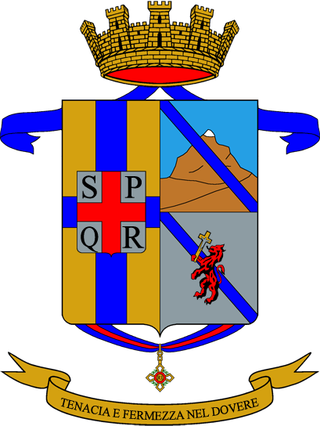
The 46th Infantry Regiment "Reggio" is an inactive unit of the Italian Army last based in Palermo. The regiment is named for the city of Reggio Emilia and part of the Italian Army's infantry arm. On 8 August 1859, a Volunteer Battalion was formed in Modena, which soon was assigned with two other volunteer battalions to the newly formed 4th Infantry Regiment. The new regiment was assigned, together with the 3rd Infantry Regiment, to the newly formed Brigade "Reggio" of the Army of the League of Central Italy. On 1 January 1860, the 4th Infantry Regiment was renumbered 46th Infantry Regiment, and on 25 March 1860, the regiment joined the Royal Sardinian Army.

The siege of Messina during the Sicilian Revolution of 1848 was the final moment in a series of events that, from January to September of that year, pitted the forces of the Sicilian insurgents and those of the Bourbon army against each other in Messina, which, after a series of defeats, recaptured the city at the end of a heavy bombardment. Rather than a siege in the classical sense of the term, it can be described as a very long military operational cycle, with an uninterrupted succession of clashes of varying magnitude and scope.

















